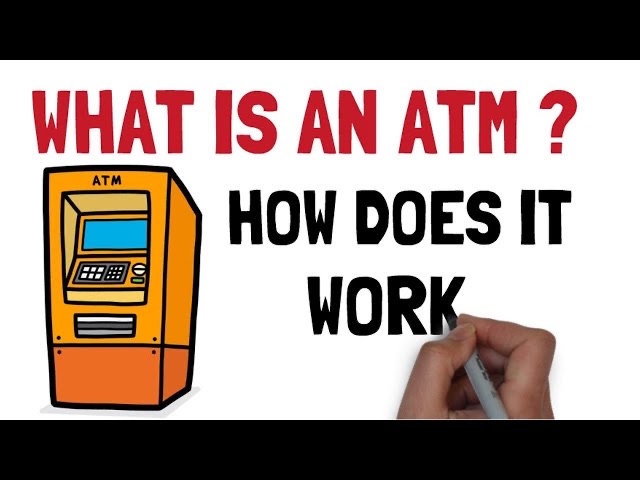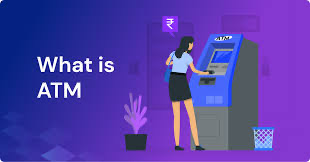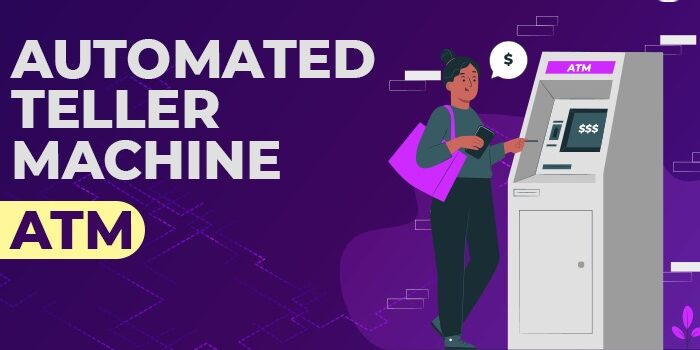What is ATM? Automated Teller Machines, commonly known as ATMs, are utilized for conducting banking transactions. Having a comprehensive understanding of ATM operations is essential for individuals engaged in banking or financial activities. This article delves into the definition of ATMs and their diverse functionalities. Additionally, it provides a detailed explanation of the operational process of ATMs, enabling users to carry out actions like withdrawing cash, making deposits, transferring funds, and checking balances.

What is ATM? Meaning, ATM Full Form, History, Benefits & How ATM Works?
ATMs, or Automated Teller Machines, are versatile devices that enable both deposits and withdrawals. These sophisticated mechatronic tools are predominantly utilized for cash withdrawals, offering self-service banking options through smart cards or magnetic code cards. With the ability to perform various functions like cash withdrawals, fund transfers, and balance inquiries, ATMs streamline banking operations and replace the need for traditional bank tellers. Categorized based on installation location, ATMs are commonly grouped into independent, interior, and outdoor units. Indoor ATMs can further be classified as wall-through or lobby models, while outdoor ATMs vary in security levels with some enclosed in booths. The appearance of outdoor ATMs can be distinguished by fully or partially enclosed designs, with the former further categorized into square or round structures.
Definition of ATM
ATM stands for an “Automated Teller Machine”. An ATM is a computerized device that enables individuals to conduct various banking transactions without the need for a human teller. It provides a convenient way to access and manage our bank accounts, even outside the banking hours.
Full Form of ATM
Earlier, it was explained that ATM is an abbreviation for “Automated Teller Machine.” The word “automated” denotes the machine’s capacity to execute functions automatically, without human involvement. “Teller” signifies a bank staff member responsible for cash transactions. Hence, the term ATM effectively portrays a machine that undertakes tasks conventionally done by a human teller.
History of ATMs
1. The Birth of ATMs
The origins of ATMs can be dated back to the 1960s when Barclays Bank in London, England, introduced the first ATM in 1967. This initial ATM was a basic machine that enabled customers to withdraw a specific sum of money by utilizing a customized paper voucher and a personal identification number (PIN). The primary goal of this innovative development was to enhance customer convenience and minimize reliance on human tellers.
2. The Magnetic Stripe Revolution
During the early 1970s, ATM technology was transformed by the arrival of magnetic stripes. Magnetic stripe cards allowed customers to conveniently access their bank accounts by inserting the cards into the machine, eliminating the requirement for paper vouchers and enhancing the user experience. Furthermore, this innovation laid the foundation for future advancements in ATM technology.
3. Networked ATMs and Shared Banking
In the late 1970s and early 1980s, the idea of networked ATMs was introduced. This allowed ATMs from various banks to link to a central network, giving customers the ability to use their accounts at any ATM belonging to a participating bank. This advancement brought about increased convenience, as customers were no longer restricted to their own bank’s ATMs for withdrawing cash. It signified a major advancement in the history of ATMs.
4. Enhanced Functionality and User Interface
During the 1990s, ATMs went through significant changes. Banks started to offer ATMs with advanced features like cash and check deposits, account fund transfers, and bill payments. These upgrades broadened the services available to customers at ATMs, further integrating them into daily life. The user interfaces also saw notable enhancements. Older ATMs had basic screens and few buttons, but technological progress brought about full-color displays, touchscreens, and intuitive graphical interfaces, making ATM usage more user-friendly and intuitive.
What is ATM Automated Teller Machine?
ATM, short for Automated Teller Machine, is a self-service banking terminal that allows users to perform various transactions such as cash withdrawals, balance inquiries, and fund transfers. Different banks offer ATM services through the placement of cash machines across various locations. Users can withdraw money from any of these ATMs regardless of whether they hold an account with the specific bank. Transaction fees at ATMs may either be free or subject to a small fee, depending on the bank’s policy. Typically, banks do not impose charges for the initial 3-5 ATM transactions per month, but exceeding this limit may result in nominal fees. Additionally, some banks may apply charges for withdrawals made from ATMs of other banks where the user does not hold an account.
Types of an ATM
- Brown-label ATMs
- Orange-label ATMs
- White-label ATMs
- Yellow-label ATMs
- Green-label ATMs
- Pink-label ATMs
- Complex or full-service units
- Basic units
- Off-site ATMs
- On-site ATMs
Types of Automated Teller Machines (ATMs)
Automated Teller Machines (ATMs) come in two main types. One is a basic unit that allows cash withdrawals, balance checks, PIN changes, mini statements, and account updates. The more advanced units offer services such as cash or check deposits, line of credit, and bill payments. ATMs are classified as onsite or offsite, with onsite ATMs located within bank premises and offsite ATMs scattered across various locations to provide essential banking services and immediate cash access to those unable to visit a bank branch. Additionally, ATMs can be grouped based on the labels assigned to them.
- Green Label ATMs- Used for agricultural purposes
- Yellow Label ATMs- Used for e-commerce transactions
- Orange Label ATMs- Used for share transactions
- Pink Label ATMs- Specifically for females to help avoid the long queues and waiting time
- White Label ATMs – Introduced by the TATA group, white label ATMs are not owned by a particular bank but by entities other than the bank
- Brown Label Banks- Operated by a third party other than a bank
How Does an ATM Work?
Upon understanding the concept of an ATM, let’s explore its operational process. Essentially, an ATM comprises both hardware and software elements. When engaging with an ATM, you insert your plastic card, typically a debit or credit card, into the designated slot. This card includes a magnetic stripe or chip that holds your account particulars. Following card insertion, you are required to input a Personal Identification Number (PIN) to verify your identity as the account holder. After successful verification, the ATM connects to your bank’s network to access your account information. Consequently, you can conduct a range of transactions like cash withdrawals, balance inquiries, fund transfers, and bill payments.
Uses of an Automated Teller Machine
Automated Teller Machines have transformed the banking industry by offering convenient customer access and reducing the workload on bank staff. Various purposes of an ATM include:
- Users can typically withdraw money and check their account balance at an ATM. Additionally, bank account holders have the option to transfer funds or modify their PIN (Personal Identification Number).
- Newer and more advanced ATMs offer the ability to open or withdraw a Fixed Deposit (FD), as well as apply for a personal loan. Other services include booking railway tickets, paying insurance premiums, income tax, and utility bills, recharging your mobile, and depositing cash. Certain services may necessitate registration at the bank branch.
- Customers have the convenience to conduct direct transactions. Today, banks have placed their ATMs in various public locations such as highways, malls, markets, railway/airport stations, hospitals, and more.
- Automated Teller Machines provide 24×7 access anywhere and at any time
- ATMs assist in avoiding the inconvenience of waiting in lengthy lines at the bank, even for basic transactions such as cash withdrawals. Additionally, they have aided in decreasing the workload of bank employees.
How to Use ATMs?
To use Automated Teller Machines, you must have a bank account and an ATM card linked to the account. Banks typically provide a debit card that can be utilized at ATMs, online payment gateways, and for card swipe transactions. While Automated Teller Machines vary in size and design, they share common basic components..
Input Devices
Card Reader – Every Automated Teller Machine has a space to insert the debit or the ATM card. The ATM card generally has a magnetic strip on the back, and in a few cases, a chip on the front, that contains the account details. Card Reader recognizes these details and passes them on to the user server
Keypad – All ATMs have a keypad where you can insert numbers, clear them, or cancel any transaction. You can use it to enter the PIN and the amount you wish to withdraw. These keypads can either be physical buttons on the ATM or virtual keypads on the touchscreen
Output Devices
Display Screen – There is a display screen in every ATM, usually LCD or CRT that displays the transaction information like steps to do the transaction or balance after withdrawal. Therefore, it acts as a guide to performing a transaction. It displays options of PIN change, quick cash withdrawal, balance check, etc.
Cash Dispenser – Cash is safely stocked into the Automated Teller Machine by bank officials. There is a cash dispenser from where you can collect cash after withdrawing a certain amount from the ATM
Receipt Printer – Upon finishing a transaction, the ATM’s receipt printer documents details such as the transaction type, withdrawn amount, and remaining balance. Typically, during a transaction, ATMs prompt customers to choose whether they wish to receive a receipt. Consequently, if requested, a receipt is issued from the printer.
Speaker – There is a speaker in most of the ATMs which gives the audio instructions for accessing the machine & doing transactions. Therefore, it further enables the users to perform the transaction smoothly
How can you Operate an ATM?
Below is a detailed guide on operating an ATM machine:
Approach the ATM: Walk up to the ATM and ensure that the surrounding area is safe and well-lit. Be cautious of anyone behaving suspiciously nearby.
Insert your card: Locate the card slot on the ATM and insert your debit or credit card with the card’s magnetic strip facing down or the chip facing up, depending on the type of card and ATM. Follow the on-screen instructions if any.
Enter your PIN: Once the card is inserted, the ATM will prompt you to enter your Personal Identification Number (PIN). Carefully enter your PIN using the keypad provided. Ensure that you shield the keypad with your hand or body to prevent others from seeing your PIN.
Select your transaction: After entering your PIN, the ATM will display a menu of transaction options on the screen. Common options include withdrawals, deposits, balance inquiries, and fund transfers. Select the transaction you want to perform by pressing the corresponding button on the keypad.
Follow on-screen instructions: The ATM will provide step-by-step instructions for each transaction. Read the instructions carefully and follow them accordingly.
Withdrawal: If you choose to withdraw cash, enter the amount you wish to withdraw and confirm the transaction. The ATM will dispense the requested amount in cash.
Deposits: If you want to deposit cash or checks, the ATM will guide you on the specific procedure. Some ATMs require you to insert checks or cash directly into designated slots, while others may provide envelopes for you to place your deposits.
Transaction completion: Once you have completed your transaction, the ATM will display a summary of the transaction details on the screen. Take note of any important information or receipts provided.
Collect your card and cash: After completing your transaction, the ATM will return your card. Remember to take your card back from the machine. If you made a cash withdrawal, collect the dispensed cash as well.
Confirm your transaction: Take a moment to confirm that you have collected your card and cash before leaving the ATM area. If there are any issues or discrepancies, contact your bank immediately.
How to use an ATM to check your balance
- Locate the ATM’s card slot and slide the bank card into it in the direction that the card’s arrow points.
- To avoid making mistakes when operating, carefully read the tips. To access the card inquiry option, click the confirmation key.
Benefits of an ATM Regarding Privacy
Cash card replacement procedures can be lengthy, and the card is only functional when physically present. However, this service allows users to transact without the physical card. By downloading the app on a new device, users can deposit and withdraw money instantly, even if the original card is lost. The time taken for this process differs significantly from that of replacing a lost bank card. Furthermore, this service provides an added layer of security, alleviating concerns about losing the card.
Please remember that each action you take, such as logging into the app, will prompt you to enter your PIN. Additionally, a smartphone may offer biometric authentication or require a password at the outset, providing two or three levels of security. It is worth noting that to withdraw money with a cash card, you simply need to insert the card and enter the PIN. Alternatively, logging into the app and scanning the QR code on the ATM screen is also an option, although some may find this method more cumbersome.
Disclaimer
The article/infographic/picture/video is for information only and may not represent Bank of Baroda’s views. It provides general information, not specific advice. Bank of Baroda and its affiliates do not guarantee the accuracy, completeness, or reliability of the information. They disclaim any liability regarding it. The information may change. It should not be distributed or used where prohibited by law. Bank of Baroda is not liable for any losses due to decisions based on this information. Consult a financial advisor before deciding on finances.
Conclusion
ATMs, short for Automated Teller Machines, have transformed our banking interactions by providing a convenient way to manage accounts through services like cash withdrawals, balance checks, and fund transfers. Their 24/7 availability and user-friendly interfaces have made ATMs an essential aspect of modern banking. Remember the full form, Automated Teller Machine, when you use one, and value the technology simplifying banking tasks. While enjoying the convenience they offer, stay cautious of potential security threats.


